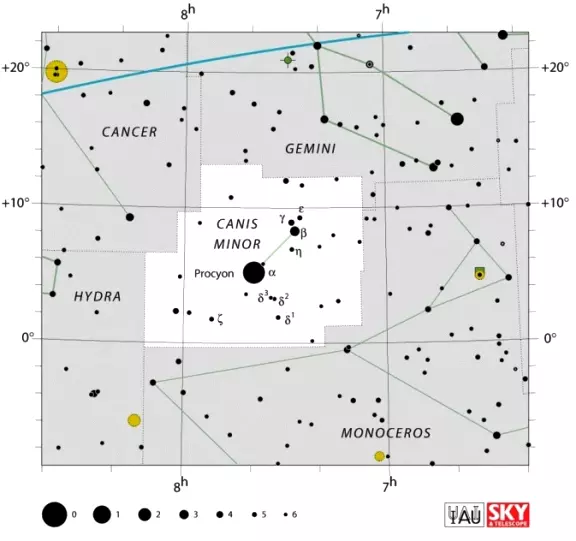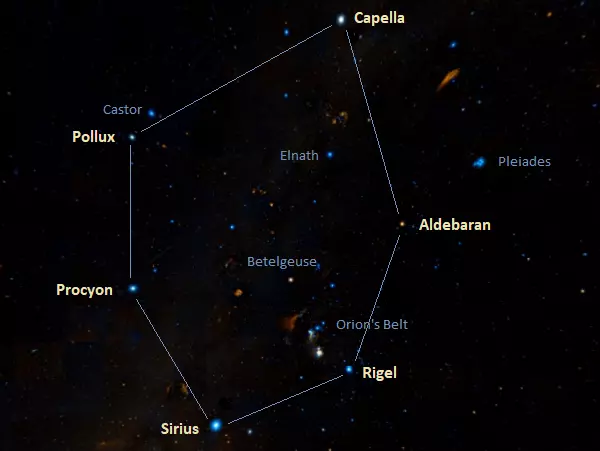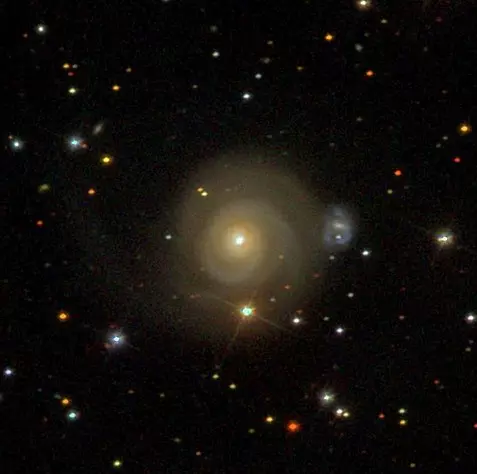Canis Minor is a small constellation in the northern sky. Its name means “the smaller dog” or “lesser dog” in Latin.
The constellation represents one of the dogs following Orion, the hunter in Greek mythology. The other dog is represented by the larger neighbouring constellation Canis Major. Both constellations were first catalogued by the Greek astronomer Ptolemy in the 2nd century.
Canis Minor is home to Procyon, one of the brightest stars in the night sky, Luyten’s Star, one of the nearest stars to Earth, and the spiral galaxy NGC 2485, among other notable objects.
Facts, location and map
Canis Minor is the 71st largest constellation in the sky, occupying an area of 183 square degrees. It is one of the 15 equatorial constellations. It lies in the second quadrant of the northern hemisphere (NQ2) and can be seen at latitudes between +90° and -75°. The neighboring constellations are Cancer, Gemini, Hydra, and Monoceros.
The constellation name Canis Minor is pronounced /ˈkeɪnɪs ˈmaɪnər/. In English, the constellation is known as the Lesser Dog. The genitive form of Canis Minor, used in star names, is Canis Minoris (pronunciation: /ˈkeɪnɪs mɪˈnɒrɪs/). The three-letter abbreviation, adopted by the International Astronomical Union (IAU) in 1922, is CMi.
Canis Minor belongs to the Orion family of constellations, along with Canis Major, Lepus, Monoceros, and Orion.
Canis Minor does not contain any Messier objects nor does it have any stars with known planets. The brightest star in the constellation is Procyon, Alpha Canis Minoris, which is also the seventh brightest star in the sky. There is one meteor shower associated with the constellation, the Canis-Minorids.
Canis Minor contains two formally named stars. The star names approved by the International Astronomical Union (IAU) are Gomeisa and Procyon.

Canis Minor constellation map by IAU and Sky&Telescope magazine
Myth
Canis Minor is most commonly identified as one of the dogs following Orion, the hunter in Greek myth. In another legend, the constellation is said to represent Maera, the dog of the unlucky wine-maker Icarius. Icarius met his end at the hands of a group of shepherds to whom he had offered wine. The shepherds had never tasted wine before and thought Icarius had poisoned them.
Maera found Icarius’ body and ran to his daughter Erigone. Both the daughter and the dog were overwhelmed with grief and took their own lives. Zeus later placed their images in the sky. In this version of the myth, Icarius is associated with Boötes, the Herdsman, Erigone with the constellation Virgo, and Maera with Canis Minor.
Hyginus (Latin author who lived at the turn of the millennium) confused the myth somewhat in his writings. He wrote that the shepherds escaped to the island of Ceos and, as punishment for their misdeed, the island was stricken with sickness and famine, which were attributed to the searing Dog Star, Sirius. (Procyon is mistaken for Sirius here, the other “dog star,” located in Canis Major.)
When Aristaeus, King of Ceos asked the god Apollo, who was also his father, for advice on saving his people from starvation, he was told to pray to Zeus. Aristaeus did so and Zeus sent Etesian winds to the island. Every year, the myth goes, Etesian winds blow for 40 days and cool Greece and its islands during the Dog Days of summer. After Zeus had sent relief to Ceos, the priests instituted the custom of making ritual sacrifices to the gods every year before the rising of Sirius.
In yet another myth, Canis Minor is identified as the Teumessian fox, the animal that could not be outrun, and was eventually turned into stone by Zeus, who also turned its hunter, Laelaps, to stone. (Laelaps was an exceptionally fast dog, destined to always catch its prey. In the myth, the dog is represented by the constellation Canis Major.) To commemorate the event, Zeus placed both animals in the sky.
Canis Minor stars
Procyon – α Canis Minoris (Alpha Canis Minoris)
Procyon is the brightest star in Canis Minor and the seventh brightest star in the sky. It has an apparent magnitude of 0.34. Procyon is not extraordinarily bright itself, but is located pretty close to the Sun; it lies only 11.41 light years away. It is the 13th nearest star system to our own.
The star’s name is derived from the Greek προκύον (prokyon), which means “before the dog.” It is also sometimes called Antecanis, which means the same thing in Latin. The star got this name because it rises before Sirius, the Dog Star, in the sky when observed from most northern latitudes.
Procyon is a binary star system, composed of a white main sequence star, Procyon A, which belongs to the spectral class F5 IV-V, and Procyon B, a DA-type faint white dwarf as the companion. Procyon A has 1.4 solar masses and is 7.5 times more luminous than the Sun, while Procyon B has 0.6 solar masses and an apparent magnitude of 10.7.
Scientists believe that life is unlikely in Procyon’s system because the habitable zone may not contain stable orbits because of the presence of the white dwarf and also because Procyon emits more of its light in the ultraviolet spectrum, which is damaging to life forms.
Procyon is part of the Winter Triangle asterism, along with Sirius in Canis Major and Betelgeuse in the constellation Orion. It is also one of the vertices of the Winter Hexagon, along with the stars Capella in Auriga, Aldebaran in Taurus, Castor and Pollux in Gemini, Rigel in Orion and Sirius in Canis Major.

Winter Hexagon, image: Wikisky
Gomeisa – β Canis Minoris (Beta Canis Minoris)
Gomeisa, the second brightest star in Canis Minor, is a hot, B8-type main sequence star classified as a Gamma Cassiopeiae variable.
It rotates rapidly and exhibits irregular variations in luminosity because of the outflow of matter. These stars are also known as shell stars because they are surrounded by a disk of ejected material, which is heated up by the stars’ emissions.
Gomeisa is approximately 170 light years distant. It has a mean apparent magnitude of 2.89, with its brightness varying between magnitudes 2.84 and 2.92.
The name Gomeisa is derived from the Arabic al-ghumaisa, which means “the bleary-eyed (woman).”
γ Canis Minoris (Gamma Canis Minoris)
Gamma CMi is a double star, a spectroscopic binary, approximately 398 light years from Earth. It has an apparent magnitude of 4.33. The main star in the system is an orange K-type giant and the unresolved companion has an orbital period of 389 days.
G Canis Minoris
G Canis Minoris (G CMi) is another binary star, approximately 261 light years distant. It is an orange K-type giant with a magnitude of 4.39.
Luyten’s Star (GJ 273)
Luyten’s Star is a red dwarf, approximately 12.36 light years from Earth. It has an apparent magnitude of 9.87, which makes it very faint to observe.
Luyten’s Star is the 22nd nearest star system to our own. The closest approach was about 13,000 years ago, when the star was within 3.67 parsecs. It is now in the process of moving away from the solar system.
Luyten’s Star was named after Willem Jacob Luyten, the Dutch-American astronomer who first determined the star’s proper motion. The star is currently located only 1.2 light years from Procyon.
Deep sky objects in Canis Minor
Canis Minor contains a number of deep sky objects, but all are very faint and difficult to observe. The brightest is the spiral galaxy NGC 2485, with an apparent magnitude of 12.4.
The galaxy is located 3.5 degrees northeast of Procyon. Its coordinates are 07:56:48.7 (right ascension), +07:28:39 (declination).

NGC 2485, image: Sloan Digital Sky Survey